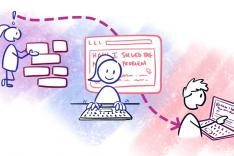Growth Through Innovation Series: Fostering Innovation Through Talent Incubation
Series Overview
This article is the third in a series about decoding the black boxes of innovation and incubation. Each article in the series is intended to be a self-contained unit, so please bookmark the first article in this series, so that you can find any piece you wish to see at any time.
Understanding the Types of Innovation
A previous article in this series examined the types and sources of innovation, and it will be helpful to recap some of the key points from that piece that will be central to discussion of Talent-centric innovation practices. This article will be delving into the ways in which internal sources (Talent) contribute to all three forms of innovation (Product, Process, and Cultural). The emphasis will be on the central tenet that properly incubated talent will properly incubate your business.
Incubation of Growth Through Talent
Among a company's richest and most ever-flowing internal sources of innovation are its employees. Companies excel when they recognize the power of each individual employee to contribute beyond their written job description, and when they implement the structure and mechanisms necessary to tap those resources. Innovative companies empower their employees with training, feedback channels, critical evaluations, and opportunities to grow and take ownership within their sphere of influence.
Tapping Existing Resources
The first and most important step in leveraging internal talent as sources of innovation is understanding the organization, its contributors, and their roles. Strategic visibility from the treetops of upper management often doesn't align with the actual operational activity on the ground, due to a number of factors including the conversion of strategic visions to actionable goals and objectives as they filter through countless layers of management. Developing a successful internal innovation strategy that leverages all internal resources requires a more conceptual approach to sourcing ideas that can be turned into initiatives that benefit the entire organization.
Leveraging Experience
Nobody knows more about the day to day operations of a company than the employees who have to do the work. A number of organizations take a "top-down" approach to innovation, even going as far as bringing in external consultants to help them improve process efficiency, drive product growth, or identify opportunities to augment the company vision and stay on the "cutting edge" of their industry's technology curve. Where these companies often miss the greatest opportunities is failing to implement or seriously consider "bottom-up" strategies as well.
Even the terms "top-down" and "bottom-up" present a cringe-worthy view of organizational structures, especially for companies that intend to leverage their internal resources toward the goal of innovation-driven growth. It is much better to consider different innovation centers within a company, and then assign each of them a set of goals they are uniquely positioned to achieve, and direct managers to build bridges between them over time. Product, Process, and Cultural innovation can all come from anywhere, so proper conduits for those ideas are critically important to establish, but understanding the opportunities that exist within a support services department, for example, is a huge step toward leveraging the expertise of every employee instead of only those with the largest salaries.
Strategic Minutiae
The majority of the shortcomings associated with directing innovation from sources other than strategic managers comes with the abandonment of strategic principles due to lack of knowledge of daily operations. Managers who attempt to set up innovation centers with customer service staff, for example, often have difficulty understanding or properly identifying "strategic minutiae." Strategic minutiae, as a concept, is the understanding that many of the details of daily operations have a number of things in common, and that being able to properly analyze them requires an understanding of those commonalities. The best example of strategic minutiae that most companies are able to leverage is the compilation of Frequently Asked Questions. This strategic minutiae is so commonplace, in fact, that many product managers include a preemptive FAQ with new product releases that addresses anticipated bottlenecks for customer service. Identifying other strategic minutiae is the best way to construct the goals of individual internal innovation centers.
Creating Innovation Centers
For organizations who will be building innovation centers from scratch, it might be best to allow an org-wide pilot program to identify hotspots within the company where there is a natural appetite for contributions. There are certain rules a company can follow to make the most of its innovation center definitions, which include the following:
- Encourage Contributions: always start by helping each and every employee feel empowered. Make a big deal out of your company's innovation program. See next section: Sourcing Ideas.
- Don't be afraid to fail: plainly and simply, not every idea is going to be good. Make sure employees and managers are prepared to handle the ones that don't make the cut effectively, and learn from them.
- Don't be afrain to manage people: innovation programs will require time commitments, and will require coaching that encourages employees to continue participating.
- Train managers to think and link strategically: not every idea will be good, and almost none of the ideas will be in their final forms. Make sure managers are empowered to work with each other when an idea could be better with the input from another innovation center. Train managers to be advocates for their own employees when interfacing with other managers.
Keep in mind that the main goal of an innovation center is to create a working environment that naturally incubates internal talent so that those employees are empowered to incubate the business through Product, Process, and Cultural Innovations. Regarding the incubation of talent, companies can train their employees directly to actively seek out ways to make things better, and they can also take time to understand the true value of each employee and how to better leverage their natural skill sets. A combination of both efforts leads to the greatest amount of success.
Incubating Talent Through Training
At the end of the day, getting innovative ideas from people who are not accustomed to contributing in that way will require training. It is important to do this in a way that does not carry undertones of micromanagement or hinder the performance of normal job functions, and to be incredibly transparent about the fact that the objective of these activities is to improve their performance and satisfaction while also helping the company achieve its own goals of delivering better products and services to its customers. The exact types of training will vary by innovation center, but an example of how to train employees to look for opportunities includes the following:
- What is the hardest part of the job? of each task?
- What takes the most time to do?
- What took the longest to learn? to master?
- Common Problems
- Common Solutions
- Things they do the same way every time
Perhaps the most replicable model for employee training comes with adherence to a set of outcomes as part of the development of innovation centers. First, employees should be aware of the program, the goals of the program, the tools available to them, and the benefits of participation. Next, employees should be trained in whatever ways will result in them being able to identify strategic minutiae in their job functions, and then evaluate those for opportunities. Finally, employees need to be trained to communicate those opportunities through the proper channels.
Incubating Talent Through Critical Evaluations
It's not uncommon for a company to hire an employee that has the ability to contribute far beyond the role for which they were hired, and then never actually leverage or properly incubate that talent. This is where the complication of role-based hiring (a topic covered in part 4 of this series) can actually stymie innovation by forcing managers into an agility conundrum. To avoid this problem, innovative companies must focus on performing critical evaluations of each employee that go beyond their job performance.
Employee profiles should be continuously updated to have a complete picture of what that employee does best, which means they must be given opportunities to participate in job functions outside of the ones they were hired to perform. These evaluations must also examine the sources, skills, and personality traits that contribute to their success, and how those unique traits can be leveraged in other ways. For example, your best customer service representative might actually be an exceptional product manager by nature, because the thing that makes them particularly effective when delivering customer solutions is their penchant for taking a keen interest in the true source of the customer's problem. That level of attention to the needs of a customer is a critically important skill for a product manager when it comes to identifying product requirements, so incubating that talent could result in the development of an employee that make significant contributions in the form of product innovations.
When critical evaluations are properly executed, they should probably result in managers that need to ask "does that job exist?" The answer to that question should also be followed by "why or why not?" and "can it or should it?" in a truly innovative organization. Modifying an employee's job description to fit their talents is a critical piece of leveraging the full extent of a company's internal resources. Incubating talent and giving employees the best opportunity to contribute as meaningfully as possible will lead to significantly more successful innovation centers.
Creating Innovation Infrastructure
Once a company has successfully identified the best ways to leverage their internal resources toward innovation goals, and established the proper innovation centers within their organizational structure, it is equally important to put in place the channels, mechanisms, and incentives to bring that innovative activity to the rest of the company. This infrastructure breaks down into four critical phased components: Sourcing, Conversion, Implementation, and Learning.
Sourcing Ideas
The majority of the content in this article up to this point lays the groundwork necessary to foster an environment that makes it possible to source ideas from internal talent. When it comes time to actually source those ideas so that they can be applied to business goals, there are a number of methods that are popular and effective. Many companies make the mistake of trying these methods without the aforementioned groundwork, or without the other components of this infrastructure, which is the most common source of failure for programs like these.
Innovation Events
The Hackathon: a mid-2000s buzzword that became the sexiest and most exciting thing a performatively innovative company can do. Genuine hackathons are still incredibly effective vehicles for high-level product innovation. Lock a bunch of the biggest brains in a room for a period of time with energy drinks, whiteboards, laptops, pizza, and problems to solve, shake vigorously, then dump all of the resulting solutions into the battle arena, in which the least exhausted member of each team advocates for their solutions. It's thrilling, fun, and effective, and it represents the pinnacle of silicon valley culture. The collective concentration and dedication of each and every one of a company's most powerful resources to a single problem in a coopertition effort to solve it in hours instead of weeks or months is fundamentally special. Hackathons, however, are not the ideal vehicle for passive innovation efforts, and typically aren't configured to be great vehicles for process innovation or cultural innovation.
Outside of hackathons, companies can organize other kinds of events and activities that are great ways to get non-engineer and non-specialists involved in company innovations. The goals of these events should be to provide a forum for open communication of problems and solutions, as well as the opportunity for employees to take interest and ownership in solving problems outside of their primary job function.
Town Halls
Town Hall meetings are highly effective communication forums that have been around for centuries, and they are a breeding ground for innovation and ideas. When applied to a business setting, Town Hall meetings should be small and frequent, and should scale up to larger group representative Town Halls. This gives organizations the ability to focus their innovative opportunities within teams, refine them, and then communicate them outward for crowd-sourced support. The representative model also presents the opportunity for ownership of ideas, which empowers employees to elevate their own platform to potentially the highest levels in the company. Town Halls provide the most collaborative setting for the proliferation of ideas, solving of problems, and development of innovations.
Challenges
Challenges present a fantastic competitive counterpart to Town Halls, and provide incentive for participation for the types of employees whose motives to contribute are different from those who would seek to use the Town Hall as a vehicle to set their ideas in motion. Challenges can resemble hackathons, but are typically more structured and take place over a longer period of time. The keys to running successful challenge events are:
- Frequency should be minimal to encourage people to only submit their "best" ideas
- Problem scenario should be clearly articulated
- Teams should be encouraged
- Mentors should be available
- Multiple stages of judging
- Significant recognition and "internal press"
Innovation Blogs
Every company should at least publish an internal blog detailing its innovation program, how to participate in activities, news, successes, and employee spotlights. Recognition and appreciation are critical rewards for everyone participating in internal innovation programs, and making it part of daily routines will require people to see a commitment to the program from an administrative perspective. To the extent to which companies are active publishers on their external blogs and social media properties, there should be proportionately dedicated content for the innovation program as well.
Creative Time
This is a popular "perk" at some of the more innovative software companies, particularly Google, who famously borrowed 3M's 15% project in the creation of their 20% time initiative for employees. The short version is that each company that has a program like this essentially mandates that employees spend some percentage (see the number in the name of the initiative) of their paid work time to the pursuit of personal projects. At Google, 20% time meant regular employees would dedicate ~8 hours a week to their own personal projects, and the outcome was significant. Some of Google's most recognized projects came from 20% time, like, for example, Gmail and AdSense. According to a number of sources, Google has since discontinued 20% time in practice, but many people say that the culture still encourages it, unofficially.
Whether or not it makes sense to create a program like 20% time for a company is dependent upon a litany of factors too vast to enumerate in this article, but the theory behind dedicating paid resource time to an innovation program is without question among the most important factors to ensuring its success. Asking employees to contribute extra efforts to helping the company grow outside of their normal job functions requires a commitment from the company to the program's success. This means placing a value on those employee contributions by allowing them to spend some of their paid time working on ideas and initiatives for Town Halls, Challenges, Hackathons, and other activities. It also means making managers available for dedicated discussion of these ideas more regularly.
Submission Tools
Finally, a proper innovation program must have a vehicle for submitting ideas and for managing them as they move through the process. There are a number of third party software tools that can be used for something like this, but internal processes are just as effective, as long as they are communicated thoroughly and effectively, and access to them is available to all employees. Nobody should be daunted by the submission process to get their ideas into the pipeline, so dedicated innovation center leaders should also make themselves available to help anyone who is not comfortable with whatever process and tools the company chooses to use.
Converting Ideas to Initiatives
Once ideas have been submitted, it is critical to have a transparent process that transforms the idea into an actionable initiative. Transparency can be achieved in a number of ways, but equally important to transparency is ownership and the ability of the employee who submitted the idea to manage its growth as it goes through the process of revision and definition. Always remember that internal innovation requires incubation of talent, and every person who chooses to participate in the process should be able to see how their idea becomes a tangible change, if for no other reason than for them to learn and be able to submit more ideas or even mentor others in the future.
Transparency
Transparency helps employees understand the process as they watch countless examples of ideas moving through the internal innovation machine. It provides encouragement that their ideas do not have to be perfect, and that they don't have to be major ground-breaking innovations to be valuable and worth the time. The feedback process is also critically important to help people understand why a particular idea might not make it through to implementation, so employees don't get discouraged and assume some other factors contributed.
Ownership
Ownership of ideas is the backbone of the pride that will fuel the engine of innovation among non-managerial employees. Anyone who submits an idea must be given the opportunity to work with managers and mentors to carry that idea through to fruition if it goes that far. In addition to boosting morale and encouraging people to actually participate in their innovation centers, ownership of an idea and initiative process will provide a tremendous opportunity for training that reinforces the investment in internal resources. Always take opportunities to incubate internal talent, as it fosters mutual respect and a stronger company culture that will ultimately result in a desirable working environment that attracts even more talent that sees opportunity to grow.
Implementing Initiatives
Implementation of initiatives that come out of innovation centers will also be significantly more effective when employees have at least partial ownership over the process of bringing those ideas to fruition. With natural champions and internal evangelists, especially for process and cultural innovations, adoption goals will be significantly easier to achieve. Product innovations obviously require people with specific skill sets to drive them, but as mentioned above, this also presents a mentoring and training opportunity for the person or people responsible for catalyzing those initiatives. Many employees will ultimately opt out of participating in the product innovation process, but keeping them informed of the progress is important, and providing positive reinforcement by letting them be involved in the testing process is another touch point that can bolster their connection to the project.
Tracking, Testing, and Learning
Specifically related to process and cultural innovations, it is critically important to monitor and measure the effects of changes on the organization as a whole. While these types of innovations don't always have quantifiable benefits, there are always opportunities to measure success in the long run. It is also possible that one process innovation begets others, or makes it possible for employees to identify another area that could benefit from a similar improvement, so paying close attention to the effects of applying internal innovation is an important piece of the continued success of innovation centers.
Wrapping Up
Each article in this series is a self contained unit that is intended to help companies of any size become better innovators and cultivate more innovative teams and work environments. If we can provide any additional clarity or assistance with any of the content you find in these articles, please reach out any time and reference the Growth Through Innovation Series.






